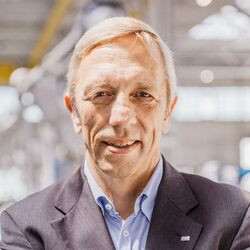
The growing number of robots in mass production is part of a decades-long success story in relieving people from the burden of repetitive, ergonomically difficult, physically demanding and even dangerous work. Highly efficient six-axis robots and Scara or Delta systems ensure consistent quality in welding, painting, machine loading and workpiece processing tasks, quickly and around the clock. New, collaborative robots working side by side with people, plus numerous technological advances in programming, diagnostics and accuracy, have paved the way to a wealth of highly economical solutions in a wide range of uses. For proof of this success, look no further than to the over 400,000 robots installed every year.
When it comes to robot-assisted painting, the principle of use is basically the same: A tool, the paint atomizer, is moved along an object and continuously applies paint while operating with consistent, repeatable quality. Everything needed for painting, such as paints and solvents and the application technology with pumps, color changers and mixers, is carried along with the tool.
Taking a closer look at the requirements specific to painting soon reveals that these tasks cannot be solved using standard robots, which is why every manufacturer uses a number of painting robots tailored to the respective painting processes. In other words, the painting robots are modified to suit the application and not vice versa. Special characteristics include:
- All application technology is fully integrated into the robot, where it must be protected against contamination by paint overspry yet remain easy to clean
- Compliance with all necessary explosion protection requirements (ATEX3G, ATEX2G, FM)
- A robot control system perfectly combining process and movement in a single system
- Application components such as color changers, dosing pumps and reflow equipment mounted close to the atomizer, minimizing paint and flushing agent losses
- A hand axis with an interior passage large enough to accommodate the many media hoses and signal wiring to the atomizer.
Combining the implementation of these characteristics in the painting robot with the application technology and intelligent control and operating software produces optimal painting results while maximizing production efficiency. Application technology manufacturer Dürr Systems AG has incorporated these characteristics in a comprehensive range of painting robots. Given the right painting booth configuration, all vehicle models can be painted inside and outside fully automatically.
Efficient production should ensure sustainable, flawless painting processes with minimal media consumption, the best possible application efficiency and the lowest production downtime. We still have a way to go yet, but high-rotation atomizer technology will ultimately optimize application efficiency in this area.
Innovators in the application technology industry are developing solutions to reach the goal of overspray-free application. A special feature of this technology is the ability to apply paint with high edge definition. In this process, the painting robot moves an applicator along the object to be painted, while maintaining an accuracy in the range of a few tenths of a millimeter. Thin needle valves in the applicator can be individually opened and closed as needed to produce an application pattern of any design. The robot and its integrated measuring equipment ensure the requisite accuracy while smart software tools simplify programming. Initial applications include decorative paint finishing, such as two-tone body roof painting and painting motifs of all kinds on the engine hood. Promising solutions have been put to practical use in the first customer applications.
Although painting robots will remain niche products in terms of sheer numbers, the innovations they embody will continue to make substantial contributions to sustainable and efficient production processes. We look forward to what the future holds in this sector.
Image: Fully automatic interior painting of automotive bodies © Duerr Systems
IFR Secretariat
The General Secretariat is responsible for the daily management of IFR and the coordination of all major activities, events and collaboration. The General Secretariat handles all questions regarding IFR membership.

Dr. Susanne Bieller
IFR General Secretary
Phone: +49 69-6603-1502
E-Mail: secretariat(at)ifr.org

Silke Lampe
Communication Manager
Phone: +49 69-6603-1697
E-Mail: secretariat(at)ifr.org
Credits · Legal Disclaimer · Privacy Policy ·World Robotics Terms of Usage · © IFR 2025
